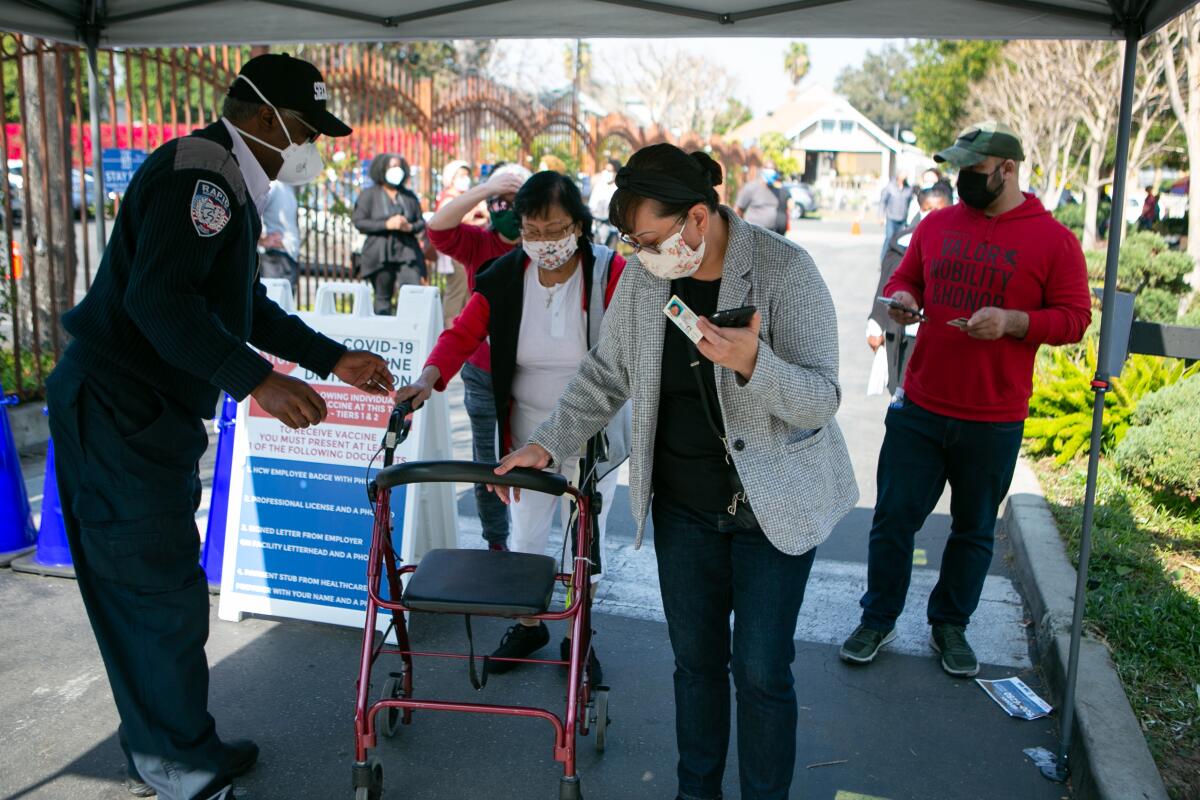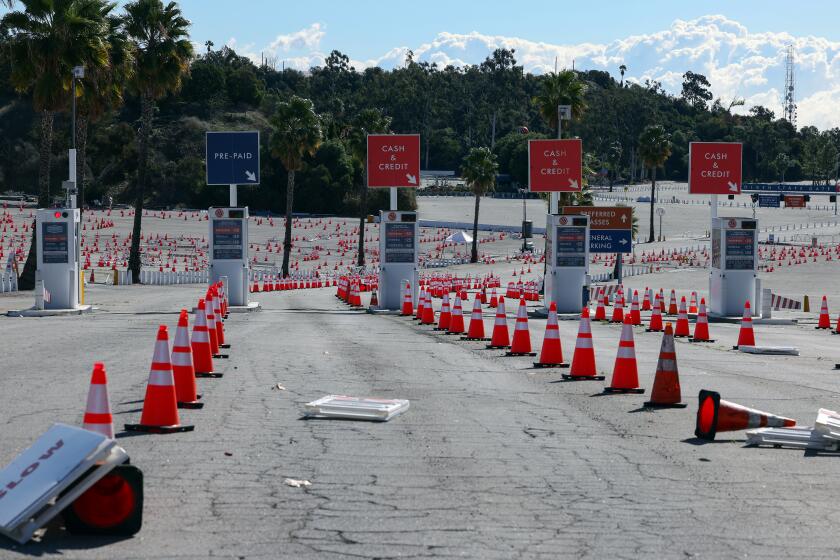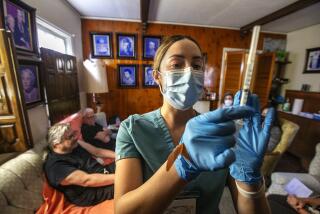New state report breaks down vaccine distribution by age, race, gender, and shows disparities

White Californians so far have received 32.7% of the first available doses of the COVID-19 vaccine, compared with 16% for Latinos, 13% for Asians, 2.9% for Black people and 0.3% for Native American populations, according to a new state report that provides a snapshot of vaccine distribution.
The new data from the California Department of Public Health for the first time break down vaccine recipients by age, race, gender and location. Due to limited supplies, healthcare workers, long-term-care residents and people 65 and older make up the largest portion of those who have received a first dose.
As of Sunday, 8,051,475 vaccine doses have been delivered to distribution sites across the state, and 5,768,684 doses have been administered. More than 8 million additional doses have been shipped.
Seniors top the list of those who have received a first dose of the vaccine, at 54.7%; followed by people ages 18-49, at 28.7%; and those ages 50-64, at 16.6%, according to the report. Women represent the majority of those who have received the vaccine, at 58.5%, compared with men, at 41.1%, and those who either declined to state gender or identified as transgender or other, at 0.4%.
The state data are also broken down by county, with disparities varying from one region to another.
California’s COVID-19 vaccine rollout has been plagued by data issues, leaving the state unable to accurately say how many doses are available at any one time.
For example, in Los Angeles County, the new report shows, Latinos have received 23.2% of the available vaccine doses; whites, 21.9%; Asian Americans, 14.6%; Black people, 4.1%; and Indigenous populations, 0.1%. By comparison, in San Diego whites have received 42.3% of the available vaccine; Latinos, 14.1%; Asians, 10.8%; Black people, 1.9%; and Indigenous populations, 0.5%.
But some Los Angeles County health officials and activists have argued that the vaccines are not being effectively targeted in communities hardest hit by the pandemic. Doses have instead gone to large vaccination centers, such as Dodger Stadium, or healthcare providers such as Kaiser Permanente.
They point out that Black, Latino and Asian populations make up a large proportion of the county’s essential workers and that many in those communities may not have access to health insurance, transportation or computers needed to register for vaccinations and therefore are being left behind.
“The playing field is not level right now,” said Dr. Don Garcia of Clínica Romero in Boyle Heights, near downtown Los Angeles.
The state data don’t tell the whole story, he said. Although Latinos appear to be vaccinated at better rates than others in L.A. County, it matters who in the community is being treated.
“I’m in that [23%],” Garcia said. “I got the vaccine without desperation ... and my patients cannot get vaccinated. That is the health inequity we are talking about.”
His clinic recently received 100 vaccines for its 12,000 mostly Latino patients, many of whom lack legal status and work in the service industry. Since March, the rate of coronavirus-positive results among those being tested at the clinic has been consistently at 40%. That’s quadruple the seven-day average positive-test rate for L.A. County overall, which was at 9.99% on Saturday.
The number of Latino residents in L.A. County who are dying daily from COVID-19 on average, over a two-week period, has skyrocketed: 40 deaths per 100,000 Latino residents. That’s nearly triple that of white residents, a segment of the population that sees an average of 14 deaths per 100,000.
Most of the Latinos who are dying are older and, in many cases, among the region’s large immigrant population. In many cases, they may not be aware of their options, and this affects the larger community.
“We’re talking about the abuelitas, tios and tias,” Garcia said. “We’re talking about the immigrants, the undocumented.”
In South L.A., Dr. Jerry Abraham is grappling with similar inequities at Kedren Community Health Center. In a matter of weeks, the clinic has managed to create a model to better distribute the vaccine doses as equitably as possible.
“When I look at those numbers,” Abraham said, “you better believe Kedren makes up a big portion of that 2.8%” of vaccines given to Black people.
The clinic started with 100 doses, which it administered to healthcare providers at Kedren and elsewhere. It has since worked to eliminate barriers for the elderly, those who don’t speak English and those who lack transportation by having volunteers and interpreters help patients register for the vaccine.
The clinic now gets 6,000 vaccine doses weekly but has been seeing up to 2,000 people daily.
“We’re in a literal arms race to find every expiring dose throughout the county,” Abraham said. “We never have enough vaccines.”
Both Garcia and Abraham say a key element to equitable vaccine distribution is taking vaccines to people in their homes and communities via fleets of mobile vaccination units.
“When you have a fire, you bring the water to put out the fire,” Garcia said. “We’re on fire. We’re the blue flame.”
The worst wave of the pandemic crested in early January. At that point, the state was recording nearly 45,000 new coronavirus cases a day.
That figure has tumbled since then — to an average of 11,180 daily cases as of Thursday, according to data compiled by The Times.
That’s still more than three times the average daily caseload California saw before the surge occurred. And there is now the presence of new and highly contagious coronavirus variants throughout the state.
On Saturday, Los Angeles County public health officials confirmed 3,254 new coronavirus cases and 197 related deaths. To date, the Public Health Department has identified 1,164,769 coronavirus cases across L.A. County and a total of 18,984 deaths.
“The cases are coming down, but they still remain high,” said L.A. County Health Officer Dr. Muntu Davis. “And so people need to understand that, even though they’re coming down, the risk of running into someone with COVID-19 who may not know it is still very high.”
California is adding 4 million to 6 million more people to the eligibility list for the COVID-19 vaccine, but officials warn that actually getting inoculated will remain a frustrating process as long as chronic shortages in supply remain.
Starting March 15, people ages 16 to 64 who are disabled or at high risk for morbidity and mortality from the coronavirus will be eligible for vaccination. That will bring the total number of Californians eligible to 17 million to 20 million.
But with supplies so limited, ultimately it will be up to local providers to decide who gets the vaccine immediately, with medical workers, first responders, people 65 and older, teachers and essential workers all vying for shots.
Physicians Garcia and Abraham said they hoped their communities would get the vaccine supplies they needed as soon as possible.
“We are used to being forgotten about,” Abraham said. “We are used to having to do a lot with very little. We do this every day, COVID or no COVID.”
Staff writers Luke Money and Rong-Gong Lin II contributed to this report.
More to Read
Sign up for Essential California
The most important California stories and recommendations in your inbox every morning.
You may occasionally receive promotional content from the Los Angeles Times.











